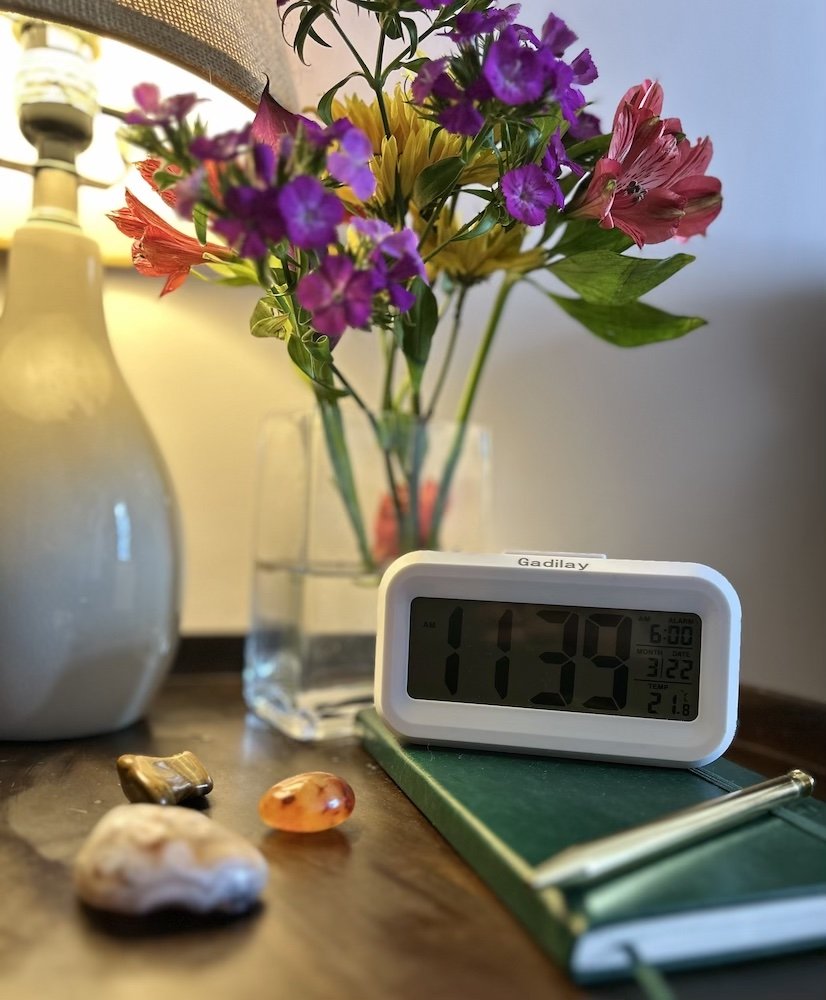City Girl Wellness: How to Start Prioritizing Wellness with a Busy Lifestyle
Whatever your health goals may be, it's likely that you’ve gone down the Google rabbit hole and at least once came to the conclusion that you may have several undiagnosed health issues. Or, in more severe cases, only a few hours to live. The desire to better yourself inevitably comes with the confusion of where to start and how to harmonize all the aspects of building healthier habits, especially within the chaos of a fast-paced environment.
For folks that live in the city, prioritizing wellness has never been more important, yet harder to achieve. Restrictions like commuting, office environments, and limited access to wider varieties of greenspaces all affect our human nature, making it harder to properly prioritize and maintain our wellness.
As with anything new in life, the best place to start is with one small step. By starting small, you’re able to focus on each need individually, and eventually you’ll find the rhythm that works best for you to consistently maintain your wellness. Below are examples of extra-small science-based ways to start prioritizing your overall health at any time and in any setting, especially busy ones.
Hydrate
Yes, duh, I know. Drinking water is commonly one of the first tips you hear when trying to improve your health. You really can’t go wrong with the most basic means of survival. Your brain and heart are composed of around 73% water. Your lungs are about 83% water and your skin contains around 64%. Less water, less function. More water, more life.
According to the Lay Press, 75% of Americans are dehydrated. That's over 200 million people. Even mild dehydration can lead to fatigue, difficulty concentrating, and headaches, which can negatively impact productivity and mood.
To build better hydration habits, a few small steps you can take include:
Splitting your intake. Drink other hydrating/nourishing liquids like coconut water, tea, natural or low-sugar fruit juice, and/or soup.
Infusing your water. If you don’t like the spectacular flavor of nothing that water has, season it! Add flavored hydration packets to your water, my current favorite is LMNT. Not only do they add a variety of flavor; the additional magnesium, potassium, and sodium restores electrolytes, boosting your hydration and energy.
Setting a reminder on your phone for every hour to drink more water throughout the day– during your commute, at work, on your break (including bathroom breaks) etc.
Investing in an ounce-labeled water bottle and carrying it everywhere you go. Tracking your water intake helps reveal any inconsistencies throughout the day. You can then set small goals to increase your daily amount from there.
Start even smaller by simply making water more visible and accessible to you. The more you can see it, the more you can condition yourself to drink it more often. The ideal amount of water you should consume varies depending on factors like sex and lifestyle, but a good rule of thumb is to drink at least half your bodyweight in ounces daily. A little more if you’re exercising, going to happy hour, or smoking regularly. No judgement, just vibes here too… but stay hydrated!
2. Move Regularly
Yes, you move your body as you commute and go about your day, but a common 9-5 entails being seated for at least 7 hours, which is 3 hours longer than the recommended amount to avoid developing health problems. Not to mention sitting while commuting and/or sitting at home. Incorporating movement throughout the workday helps combat the physical effects of sitting including poor posture, muscle stiffness, decreased circulation and worst of all, “office butt.”
By adding simple movements to your workday, you can improve mental clarity, reduce stress, boost productivity, and improve focus without needing to leave the office. Here are some simple office-exercises that bear more beneficial fruit than you may think:
Seated Leg Extensions: While seated, extend one leg at a time and hold for 5-10 seconds, then switch legs. This helps engage your quadriceps and improve circulation.
Chair Squats: Stand up and sit down slowly from your chair without using your hands. This activates the quads, glutes, and hamstrings, and improves strength, stability, and balance.
Shoulder Rolls: Roll your shoulders forward and backward in circular motions to relieve neck and shoulder tension from long periods of sitting. This movement can also help improve circulation.
Desk Push-ups: Place your hands on the edge of your desk and do push-ups to strengthen your arms, chest, and core.
Wrist and Finger Stretches: Stretch your fingers, wrists, and forearms by extending and flexing them, which can alleviate strain from typing and reduce the risk of repetitive stress injuries.
3. Gratitude Journaling
Even if you don’t find writing useful towards your mental health, gratitude journaling can be a great outlet for stress-relief. Consciously shifting your attention from what’s going wrong to what’s going well can boost self-esteem and help develop a greater sense of mindfulness, as well as reduce psychological and physiological stress.
Journaling in general can look however you want it to. You can just just speak aloud or, my favorite, speak to plants. Some gratitude journaling exercises and prompts you can start with include:
Three Good Things: Write down three things you're grateful for each day, no matter how big or small. This helps train the brain to focus on positive experiences.
Gratitude Letter: Write a letter to someone or something you're grateful for, expressing your appreciation. This exercise promotes deep reflection and connection.
Gratitude for Challenges: Sounds counterproductive, but this can help build resilience and positively shift your perspective towards many experiences in life. Reflect on a challenging situation and find something you’re thankful for in that experience.
Weekly Reflection: At the end of the week, write about the moments that stood out as particularly positive, helping you to see the big picture of gratitude amongst the mundane.
Gratitude Visualization: Don’t even have to write for this one. Close your eyes and visualize the things in your life that bring you joy, Be present with what you sense.
4. Breath:
If you can’t make a habit out of anything on this list, you have no choice with this one! The quickest way to bring yourself back from any overwhelming situation is by hanging on to your breath. Controlling your breathing can lower your blood pressure and heart rate, reduce stress hormones in the blood, improve immune function and increase feelings of calmness and wellbeing.
One of the easiest ways you can combat the stress of being busy in any setting is pursed lip breathing. This exercise reduces the number of breaths you take and keeps your airways open longer. This way, more air is able to flow in and out of your lungs so you can be more physically active. To practice pursed lip breathing, simply breathe in through your nose and breathe out at least twice as long through your mouth with pursed lips.
Other simple breathing exercises include:
Diaphragmatic Breathing: (Belly Breathing): Breathe deeply into your stomach, allowing it to rise and fall with each inhale and exhale, helping to activate the diaphragm (thin, dome-shaped muscle below the lungs & heart) and calm the nervous system.
4-7-8 Breathing: Inhale for 4 counts, hold the breath for 7 counts, and exhale slowly for 8 counts.
Box Breathing: Inhale for 4 counts, hold for 4, exhale for 4, then pause for 4.
Alternate Nostril Breathing–Nadi Shodhana: This technique originated with Ancient Indian Yogis. Close one nostril, inhale through the other, then close it and exhale through the opposite nostril.
5. Prioritize sleep
I know a full night's rest is a luxury for most. Between trying to get a decent amount of hydration, nutrition, socialization and movement, you've used up all the free hours you get with a 40+ hour work week. Not to mention parents- power to you.
If you can’t guarantee the full amount every night, you can at least make sure that the amount you do get is of good quality. Sleep is extremely important for brain function and hormonal balance. Some tips to start improving your quality of sleep include:
Avoid light before bed to signal to your body that it's time to sleep. Excess light exposure can throw off your circadian rhythm, your body’s natural sleep-wake cycle. It may also interfere with your body’s production of melatonin, the “sleep hormone.”
Control the room temperature. Aim to keep your room between 60-70 degrees fahrenheit to help with body temperature regulation throughout the night. This is also closely linked to your circadian rhythm.
Reduce screen time to help your brain wind down. Try to disconnect for at least an hour before going to bed. Read a book, stretch, draw/color, meditate, journal, or my favorite, just be.
Have a consistent wake & sleep time. It's much harder for your body to get accustomed to a healthy sleep schedule if you’re waking up and going to sleep at different times. Start small and try waking up or going to bed around the same time everyday.
Putting it into Practice: Start Small
Choose one tip from this list, depending on which aspect of your health you’d like to improve the most, and make a promise to yourself to show up for this goal everyday. Forgive yourself when you can’t, if you forget, or if you just don’t feel like it. Do try again though, especially when you don’t want to, that’s where the habit forms.
Set realistic, manageable goals, like drinking an extra glass of water or adding five minutes of stretching or walking to any part of your day. Start prioritizing sleep by avoiding light at least 30 minutes before bed. Incorporate gratitude journaling by jotting down one thing you're grateful for each week. Practice deep breathing for just a few minutes daily. There’s a lot to learn from slowing down and understanding how you function and process experiences. Prioritizing small changes can allow you to create healthier mechanisms for healthier functioning.
Achieving overall wellness is a journey, I know because I haven’t achieved it yet either. But I've learned that a small change can kickstart any goal. If you're looking for more tips on how to make wellness a priority in your busy life, explore other Wellness blogs and start making small changes towards the evolution of your Souleyness now.
Disclaimer: Information and content on this website is provided for information and educational purposes only, and is not intended as a substitute for the advice provided by your physician or other healthcare professional. No information offered here should be interpreted as a diagnosis of any disease, nor an attempt to treat or prevent or cure any disease or condition. If you have or suspect that you have a medical problem, promptly contact your healthcare provider. Do not disregard professional medical advice or delay seeking medical care because of something you have read on this website. Always speak with your healthcare professional before taking any medication, nutritional or herbal supplement. Information and statements regarding dietary supplements have not been evaluated by the Food and Drug Administration and are not intended to diagnose, treat, cure or prevent any disease.
Sources:
https://www.ncbi.nlm.nih.gov/books/NBK555956/
https://www.ncbi.nlm.nih.gov/books/NBK555956/
https://www.betterhealth.vic.gov.au/health/healthyliving/breathing-to-reduce-stress
https://www.lung.org/lung-health-diseases/wellness/breathing-exercises
https://www.sleepfoundation.org/sleep-hygiene/healthy-sleep-tips
https://www.sleepfoundation.org/circadian-rhythm
Mitchell, H.H., Hamilton, T.S., Steggerda, F.R., and Bean, H.W., 1945, The chemical composition of the adult human body and its bearing on the biochemistry of growth: Journal of Biological Chemistry, v. 158, issue 3, p. 625-637.





